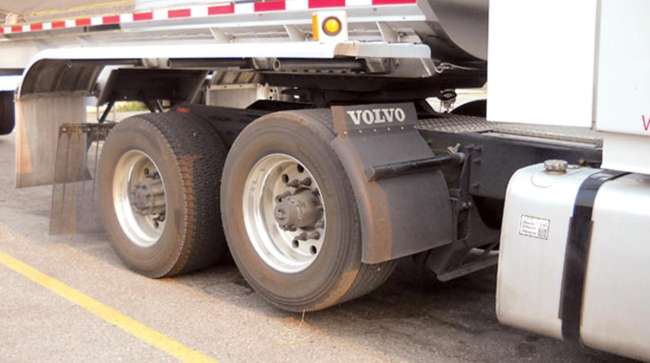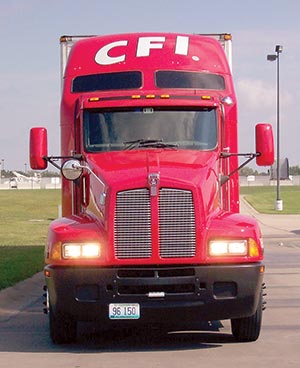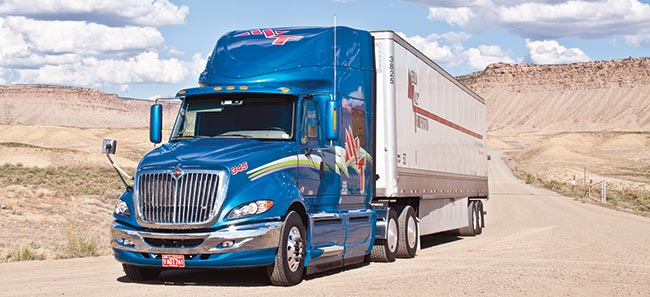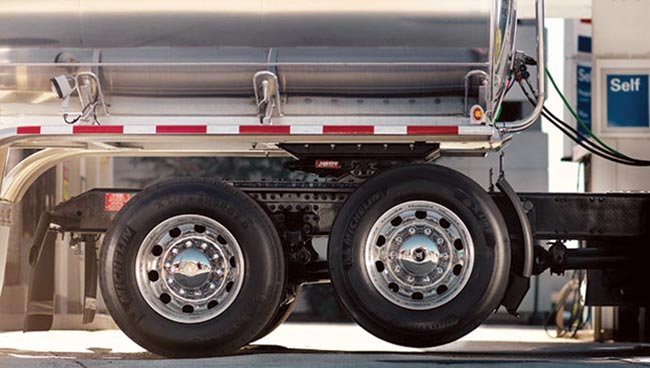Fleets Consider Benefits, Costs of 6x2 Axle Configurations

[Stay on top of transportation news: Get TTNews in your inbox.]
Are 6x2 axle configurations a good way to boost the efficiency of heavy-duty trucks, or do the complications outweigh the benefits? The answer varies from one fleet to another.
CFI has all but given up on 6x2s. Mesilla Valley Transportation remains a huge believer in them. And Nussbaum Transportation is reluctantly — and perhaps temporarily — going back to standard 6x4s because a new truck model better fits its needs.
These cases illustrate the challenges fleets face as they decide whether or not to embrace the 6x2 configuration, which saves fuel and weight but also can present trade-offs with traction, driver acceptance and resale values.
In a 2017 report, the North American Council for Freight Efficiency found that fleets that switched to a 6x2 axle configuration — in which only one of the tractor’s two rear axles is powered — could reduce fuel consumption by about 2.5%. Individual participants in the study saw improvements ranging from 1.6% to 4.6%.

A CFI truck. (CFI)
Industry adoption of 6x2s had risen gradually to 4-5% in 2016, up from 2% in 2003, when NACFE published its first confidence report on the subject. But in the past few years, momentum for the 6x2 configuration has “stopped or slowed a good bit,” said Mike Roeth, NACFE’s executive director.
“All told, we saw it grow to maybe 5% of the market, kind of plateau there, and now the industry is really kind of teetering on whether to buy more or buy less,” he said. “And it’s pretty much coming down to fuel price and what the truck manufacturers are doing with it, because many of those guys are recognizing that it’s a tough thing to implement in the field, and it makes them look bad if the fleet isn’t taking advantage of the technology in the best way possible.”
In 2014, CFI’s entire fleet had 6x2s. But the next year, the Joplin, Mo.-based company decided to spec 6x4s, and today all of its more than 1,900 company-owned trucks have that configuration.
Steve Studer, director of maintenance at CFI, said in an e-mail that lower resale values were the main reason for his fleet’s reversal. There just wasn’t enough demand.
The company’s data showed a 0.3 mile per gallon fuel improvement, he said. But drivers grew frustrated when they would get stuck at icy parking places and had to call a tow truck.
At the same time, drive tire expenses increased by about a penny per mile because their life cycles were less than half those on a 6x4 truck. While the dead-axle tires lasted longer, it didn’t offset the higher costs for the drive-axle tires.
“It’s not something we are currently looking at trying again,” Studer said. “However I’ve learned in this industry you ‘never say never.’ It would be irresponsible not to look at ways to save on fuel costs, but at this point the secondary market would have to drive the residual value up drastically for it to make sense.”
For Las Cruces, N.M.-based Mesilla Valley Transportation, 6x2s have been the fleet’s primary configuration since 2007, and that’s not changing.
“Other people try it, and then they get away from it because they listen to the wrong people,” CEO Royal Jones said. “And I get to compete against them, so I don’t mind.”
The fleet, which runs only International trucks, made the switch for fuel mileage reasons and saves about 0.3 to 0.5 miles per gallon.
Jones said the configuration eliminates both parasitic drag and moving parts.

A Mesilla Valley Transportation truck. (Mesilla Valley Transportation)
“You just have to teach your drivers how to use it and how to not be afraid of it, and we don’t have any problem on the resale side or on the usage side, and I promise you my trucks can go through ice and snow as good as anybody with twin screws,” Jones said.
Mesilla Valley Transportation ranks No. 72 on the Transport Topics Top 100 list of the largest for-hire carriers in North America.
Meanwhile, longtime 6x2 devotee Nussbaum Transportation, based in Hudson, Ill., is moving away from the configuration, not because it wants to but because it believes it has to.
The Freightliner-only fleet has been using 6x2s for fuel mileage since 2010, but the truck maker’s newest 6x4 models have a better rear-axle ratio, 2.16:1 versus 2.28:1, and actually get better mileage for Nussbaum than the 6x2s.
Switching back to 6x4s was a difficult decision because Nussbaum had invested so much effort into maximizing 6x2s, said Tony Morthland, the fleet’s director of maintenance. The company operates a little more than 400 trucks, almost all company owned, and they were all 6x2s until this year. The company was saving 0.4 of a mile per gallon.
Equipment leasing provider Ryder System hasn’t seen much interest among fleets for 6x2 vehicles.
It tried offering some 6x2s through its full-service Ryder Integrated Logistics Group but has switched back to 6x4s. Drivers simply wouldn’t accept them because of traction problems in winter weather, so the company finally moved them to Texas where that wouldn’t be an issue.
“The only place we really found a niche market for us was somebody that was extremely weight conscious,” said Art Trahan, senior manager for national accounts technical support at Ryder.
Those cases include fuel haulers, for which weight savings of 300 pounds or more can make a big difference.
As for axle manufacturers, they are making 6x2s available with lower axle ratios.
Dana offers versions of its Spicer S175 and S172 single-drive axles with ratios as low as 1.95:1. They were released this year to support engine downspeeding and the Environmental Protection Agency’s Phase 2 greenhouse gas mandate, said Steve Mastroianni, Dana’s senior manager of drive-axle product planning.

A close-up of a Volvo truck. (Volvo Trucks)
Meritor’s FueLite axle platform will be capable of a 1.95:1 axle ratio and available for all Class 8 linehaul vehicles. The model already is available in Europe. Carlos Pinotti, Meritor’s senior director of rear drivetrain engineering, said the company is ready to begin North American production.
No one has to sell Joel Morrow on 6x2s. As the head of research and development and the senior driver at Norwalk, Ohio-based Ploger Transportation, he’s driven the majority of his 4.5 million miles on 6x2s, and even learned to drive with them when he was 13 because that is what his father’s company owned. About half of his fleet’s 50 trucks use a 6x2 configuration.
Morrow, who does consulting work for Volvo Trucks and Mack Trucks, said manufacturers in North America traditionally made inferior 6x2 products to those in Europe. But that’s changing by optimizing suspensions, parameters, torque management and other factors.
“The latest version, I think we’re there,” he said of the truck manufacturers with whom he works. “I think we’re finally on par with a 6x4 in terms of traction, handling, ride, overall driver acceptance and quite a bit better than 6x4-configured trucks in fuel economy.”
While 6x2 configurations traditionally have featured powered middle axles in front of dead “tag” axles, many newer configurations are “pushers” with the drive axle in the rear.
Chris Stadler, product marketing manager for regional haul applications at Volvo Trucks North America, said the manufacturer offers a tag axle configuration, but sales volumes are low. He said pushers offer better traction because of the physics involved.
Stadler and Peter Blonde, Volvo’s senior product marketing manager for fuel and transportation efficiency, likened it to loading the bed of a pickup truck in slippery conditions to keep it from sliding. Meanwhile, the dead axle is programmed to lift automatically when the truck senses that the load is light enough.
Stadler said the company introduced 6x2s into production in 2016 and fields more than 1,700 6x2 tractors on the road today. The 6x2 configuration saves 375 pounds over a 6x4. But when fuel prices fell, so did market momentum. He and Blonde said $3.50 a gallon is the point at which customers really would again look at 6x2s.
The configuration is most appropriate for certain applications. For example, it’s not always the best for some big sleepers, Stadler said.
“And it also takes a customer who’s really focused on their operations, meaning they’re paying attention to their duty cycles,” he said. “They’re paying attention to their payloads, and they’re maybe wanting to go more dynamic in their operations, and that’s where they can see the benefit from this product.”
Other manufacturers of 6x2s also haven’t given up on them.
Jim Nachtman, Navistar’s heavy-duty marketing director, said the International LT Series and RH Series trucks can be ordered with Meritor FueLite 6x2 rear axles. Those represent a small percentage of today’s total production, but Nachtman anticipates their popularity will increase because of fuel, weight and EPA regulation advantages.
Hendrickson, which is just now entering the 6x2 market, believes the segment has room to grow. Its Optimaax 6x2 axle for Freightliner trucks, which has not yet gone into full production, has a liftable dead axle in the middle position, said Sean Whitfield, director of marketing.
NACFE’s Roeth said the configuration could make a comeback if fuel prices rise. And truck builders may need to sell more of the configuration to reach government-required GHG levels in 2024 and 2027.
“If diesel goes up another dollar, this is one of those high-risk, high-rewards that would get back on a lot of people’s minds,” he said. “We don’t have a lot of clear 3-4% fuel economy opportunities out there. This is kind of one of them, but we’ll see.”

